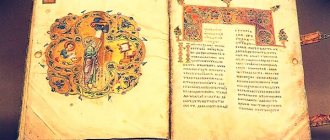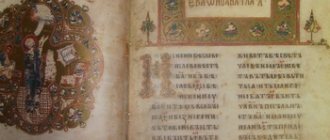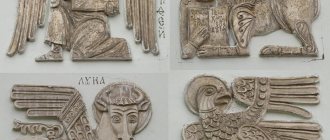11:1-2 Lazarus, whom Jesus Christ knows, falls ill. He also knows his sisters. One of them is described here: Mary, whose brother Lazarus was sick, was the one who anointed the Lord with myrrh and wiped His feet with her hair.
The incident with the anointing of the feet/head of Jesus Christ differs in detail from that described by other evangelists - in time and place of what happened (for more details, see Matt. 26:7; Mark 14: 3; Luke 7: 36-38; John 12: 3). Only John mentions that Mary, 6 days before Easter, through her actions prepared Christ for burial (John 12:1,2,7). This same Mary chose the good part when Jesus visited their home: she chose not to fuss around in the kitchen preparing many dishes, but to listen carefully to Jesus Christ (Luke 10:39).
11:3
The sisters sent to say to Him: Lord!
Behold, the one You love is sick. Lazarus, judging by the sisters' words, was more than just an acquaintance of Jesus. We know that in general Jesus loved all people, and gave his life for everyone, but he could also have special affections on earth, friends for whom he had friendly feelings, but at the same time he was not partial.
It is absolutely normal for a person to have not only acquaintances, but also very close acquaintances - friends. It is also normal to want to give friends more attention and time than just acquaintances. In a congregation of Christians, the same picture, in which among brothers and sisters there are simply acquaintances and close friends, is also absolutely normal: it is impossible to be close friends with everyone indiscriminately due to the individual personality of each person.
11:4 When Jesus heard [this], he said: This illness is not for death, but for the glory of God, that the Son of God may be glorified through it.
As we see, sometimes bad news can actually become good, depending on how you look at it: for the sisters, their brother’s illness, naturally, was a bad circumstance. For God and Jesus Christ, it could not have come at a better time: the opportunity arose to glorify God by showing the world, through the Son of God, the miracle of the resurrection from the dead.
If we learn to look at everything through God's eyes, many troubles will not seem so bad to us.
11:5,6 Jesus loved Martha and her sister and Lazarus.
As we see, striving for the Kingdom of God and becoming Christ’s does not mean not loving anyone in this world except God and Christ. And love, as you know, implies the strongest affection. We must lay down our lives for our brothers and sisters (1 John 3:16) But what does a person usually do who loves the family of his neighbors in which misfortune has happened? As a rule, he immediately rushes to help or at least for moral support. What does Jesus, who loves this family, do?
When he heard that he was sick, he stayed for two days in the place where he was.
Jesus takes his time, knowing what he is doing: he waited until Lazarus died. Does this really look like love? Didn't he want to go right away and heal Lazarus, comforting those he loved? Shouldn't he have done this? One must assume that he really wanted this, because he doesn’t like it when his loved ones suffer, and he could well have done it if it had been his own will. However, what are his desires compared to the interests and intentions of the Father? From the heights of heaven, it was much more beneficial to allow death in this house. As we see, sometimes God’s love manifests itself to us not quite the way we would like it to be.
Although many observers from the outside, aware of the message of the messengers, it might seem outwardly that if Jesus is in no hurry to respond to Lazarus’ illness and is in no hurry to heal him, it means that something is wrong, he is callous, heartless, arrogant, or something else like that kind: the human court does not hesitate to pass judgment. But the trouble is that none of the people are trained to look at the situation from the heights of heaven. That’s why it often happens that we care not about what is God’s, but about our own : we would like our brother and friend not to die, we feel bad without him, for example. And Christ just needed him to die. That's why he took his time. But at the same time, he was in no hurry to justify his delay to people.
11:7,8 After delaying two days, Jesus prepared to go to Lazarus in Judea. The disciples said to Him: Rabbi! How long have the Jews sought to stone You, and You are going there again?
This is an example of how, not being in control of the situation, the disciples sincerely do a “good deed” for Christ according to their own understanding, worrying about him and not wanting him to go to Judea again and risk himself. But in fact, it turns out that they were not worried about God’s things, but about their own: after all, if something happens, it will be they who will feel bad without Christ. In order to learn to see further and more comprehensively—not one’s own benefit, but the benefit of God’s plan—a Christian needs to rise to the heights of heaven: from a spiritual height one can better see what is happening on earth and why.
11:9,10 Are there not twelve hours in the day?
whoever walks during the day does not stumble, because he sees the light of this world; but whoever walks at night stumbles, because there is no light with him.
With these words, Jesus made it clear to his disciples that he knew what he was doing when he was about to go to Judea; he is not in darkness - with light in his mind, that is, with his right mind, he decides to go to Judea again, so the disciples do not have to worry about him in this regard.
11:11-15 Lazarus, our friend, fell asleep; but I'm going to wake him up.
Jesus, knowing that Lazarus was dead, nevertheless spoke of him as having fallen asleep. In the Russian language, for example, there is a word that quite accurately conveys the state of the deceased: “deceased.”
So, Jesus compared death to sleep, and one who sleeps in the sleep of death, it turns out, can be awakened in the same way as one who sleeps in an ordinary sleep. This is exactly what Jesus was going to go to Judea for: to wake up the dead Lazarus. And it doesn’t matter to God that little remains of the body during the sleep of death (the body of Lazarus, for example, by the time of Christ’s arrival had already begun to decompose within 4 days in the grave). The process of awakening from mortal sleep is the same in essence as from ordinary sleep: having woken up, the awakened person remains himself , the same person as he was before falling asleep, with the same habits, with the same set of knowledge and inner world.
It was precisely this process of God’s awakening from the sleep of death that Jesus planned to show to the astonished disciples and Jews - using the example of the resurrection of the dead Lazarus in order to strengthen their faith in the future opportunity from God for them to be resurrected.
His disciples said: Lord! if he falls asleep, he will recover. Jesus spoke about his death, but they thought that He was talking about an ordinary dream.
As we see, the disciples do not yet understand what Jesus is talking about in connection with Lazarus: they concluded that Lazarus had insomnia before his illness, but if he was able to sleep, it means that the healing process has begun. Therefore, they do not yet understand why they should go to Judea to heal him, exposing themselves to danger, if Lazarus himself is recovering.
Then Jesus said to them plainly: Lazarus is dead; and I rejoice for you that I was not there, so that you might believe; but let's go to him.
Why was Jesus glad that he was not there during his illness? Because, being with a sick person, waiting for his death in inaction would not be according to Christ. Lazarus would have been healed. But then the miracle of the resurrection would not have happened at Lazarus, and the disciples would not have had the opportunity to once again be convinced that Jesus is God’s.
11:16 Then Thomas, otherwise called the Twin, said to the disciples: come and we will die with him.
Thomas, having never understood the purpose of Christ’s visit to Judea, at least showed his readiness on behalf of everyone to die with Christ if he was attacked in Bethany with the desire to be stoned.
11:17,18
Jesus came and found that he had been in the tomb for four days
. Jesus stayed so long that he didn’t even make it to the funeral. Cases of the resurrection of the newly dead were known in Israel from the prophets Elijah and Elisha. Jesus also raised up Jairus' daughter and the widow's son. But there has never been an example of the resurrection of a person whose body has already begun to decay in the grave in Israel.
11:19 Many Jews came to Lazarus’ funeral, and despite the fact that Lazarus had already been buried four days ago, there were still many people in the house of Martha and Mary who came to console the sisters and share their grief. Quite opportunely, a lot of people gathered; they were all able to witness the glory of God revealed to them through Jesus Christ.
11:20,21 Martha said to Jesus: Lord! If you had been here, my brother would not have died.
Martha met Jesus far from her home (Jesus had not yet entered their village - 11:30) and did not reproach Jesus for not hastening to help Lazarus, although he had long ago learned about his illness.
She simply bitterly regretted that Jesus was not there. However, Martha’s faith in Jesus was so strong that even now she had no doubt: if Jesus wanted, then even now he could do something: But even now I know that whatever you ask God, God will give you.
From the words of Martha it is clear that she did not consider Jesus to be Jehovah God. And she considered it sent from Him. And she understood that everything is in the power of God the Father. And Jesus can only ask Him for someone. Her further conversation with Jesus shows that she herself did not know what exactly she expected from Jesus. In any case, she didn’t even think about the resurrection of her brother by Jesus:
11:23,24 Jesus says to her: Your brother will rise again. Martha said to Him: I know that He will rise again on the resurrection, on the last day.
The Jews seemed to know the theory of the resurrection of the dead on some last day from the books of the Old Testament, studying them in synagogues (the prophet Daniel was told about the time of resurrection on the “last day” after the 1335th day, that is, in the millennium of Christ, see Dan.12:13). But at that time they knew nothing about other details of the resurrection of the dead. Not long ago, Jesus said that the dead would come out of their graves according to his voice (John 5:28,29). Now was the opportunity to demonstrate this to the Jews. Jesus also explained something else to them about the resurrection of the dead:
11:25,26 Jesus said to her: I am the resurrection and the life; He who believes in Me, even if he dies, will live.
Jesus reveals to Martha that the future resurrection of everyone and the possibility of eternal life depend on him.
If you accept Christ as your savior from death, if you trust him in everything, then even death is not terrible: Jesus will be able to resurrect even a dead believer, and even one whose body is decaying (Lazarus’ body has already begun to decompose, as we will learn below). And everyone who lives and believes in Me will never die.
Do you believe this? Did Jesus say by this that the disciples of Christ will live forever in this century, starting from the minute they accepted Christ?
Of course not. For for this wicked age, death is a just retribution for the sins of every descendant of Adam (they all die justly punished, Rom. 6:23). Therefore, all the descendants of Adam are destined to die once (Heb. 9:27). The apostles died, the rest of Christ’s disciples also die to this day. Or maybe there is simply not a single believer truly from the point of view of Christ, if everyone dies despite the fact that Jesus said so?
No, and this option is not suitable: the Apostle Paul, for example, retained his faith in Christ to the end and knew for sure that the crown of glory in the form of eternal life was being prepared for him in heaven (2 Tim. 4:7,8). Why then is there not a single believer who lives forever - in fulfillment of these words of Christ? Because in saying this, Jesus only spoke about the capabilities of God in relation to this specific situation in which the dead Lazarus and the Jews living at that time “participated”: Lazarus, who died at that time, was able to come to life thanks to Christ, and the Jews living at that time , like all subsequent generations of people - if they believe in Christ, they will be able to receive eternal life - also thanks to Christ (a non-believer will not live forever). That is, these words And everyone who lives and believes in Me will never die. Do you believe this?
You can also write it like this:
And everyone who lives and believes in Me can live forever.
Do you believe this? That's all. But when will they be able to live forever?
Jesus spoke about eternal life only in connection with the age to come (future), dividing the history of mankind into this time (this age) and the age to come - Mark 10:29,30: there is no one who has left (all) and will not receive now , during this
a hundred times more... and
in the age to come eternal life
.
Note:
Jehovah's Witnesses use this text to argue for the existence of Armageddon survivors, those who among the living believers of this age will not die forever. Here they showed why this text cannot be used in such an interpretation and why everyone who lives to see it will die in Armageddon.
However, it should be noted: even if we take this text in its literal sense, it can only be applied to the future heavenly priests of God and co-kings of Christ (Rev. 20:4,6). Why? Expression Whoever lives and believes in Me will never die -
speaks about those servants of God (true believers) who will still see the second coming of Christ during their lifetime, see analysis of 1 Cor. 15:51-54, briefly from there:
It is known that in the period of the New Testament, only 144,000 servants of God will be recognized as true believers (like Christ in faith) only 144,000 servants of God, who remained faithful to him in the struggle for the truth and testimony of Christ (Rev. 7: 3,4; 20: 4, all the rest are still servants of God absolutely not recognized
).
For their loyalty, these slaves are given a place in heaven
, to lead to holiness all others who in this age have not yet been able to become God's servant (Heb. 11:40, Luke 22:29,30). Without exception, all the servants of God will be killed equally, for the word of God - even the last prophets of God - Rev. 6:9-11, 11:7). They will all be resurrected and go to heaven together as the firstborn of God (1 Thessalonians 4:16,17: Rev.14:1:4).
The last slaves will not experience transformation into dust due to death, they will change in the body quickly, like Christ: for their flesh will not have time to decay, since they will be dead for only 3.5 days and resurrected to eternal life, the second death will affect them will not be (Rev. 11:7,8,12.: 20:4,6
That is why it can be said about them that everyone living
(a servant at the time of the second coming)
and he who believes in Me will never die
11:27
She says to Him: Thus, Lord!
I believe that You are the Christ, the Son of God, coming into the world . Martha, when asked by Christ whether she believes in eternal life, answered the main thing: she believes that Jesus is the Messiah and the son of God, which means that there is no need to worry about all the promises of God.
11:28 Having said this, she went and secretly called Mary, her sister, saying: The Teacher is here and is calling you.
Martha could well have told her sister openly and loudly about the Teacher’s coming in front of everyone in the house. However, she did not want to stage a performance from the parish of Christ, so as not to damage it: she knew about the hostility of the Jews towards him. This is a lesson on privacy. You shouldn’t even spread the truth if it can harm an innocent person.
11:29-31 The Jews who were with her in the house and comforted her, seeing that Mary hastily got up and went out, followed her, believing that she had gone to the tomb to cry there.
Even Martha's precautions did not help protect Jesus from confrontation with the Jews. But in this case, close attention and the desire to accompany the grieving Mary everywhere benefited the Jews: following Mary, the Jews found themselves at the epicenter of amazing events at the tomb of Lazarus.
11:32-35
When Jesus saw (Mary) weeping and the Jews who came with her weeping, He Himself was grieved in spirit and was indignant….
Jesus shed tears The love of Christ is often said on stage that it is love based solely on principles and cold (common) reason. As we see, those who teach this way do not understand, it turns out, the love of Christ: in his love, not only the calculation of the principles of God is carried out. His love is permeated with warm feelings for people, compassion and deep empathy. Therefore, although he knew that he would resurrect Lazarus, nevertheless, Jesus was imbued with the grief of Martha and Mary, and, having passed through their grief through himself, he felt their pain from the loss of a loved one, and therefore shared their grief with them, and that is why his tears shed , and he grieved in spirit and was indignant at the deplorable state of affairs on earth.
Jesus did not hesitate to cry in the presence of people for the dead. And he did not consider the manifestation of feelings a sign of weakness of character among men or a lack of faith in the resurrection of the dead among believers. And if today we grieve for our deceased loved ones, this does not mean at all that we do not believe enough in the resurrection or are weak in character. It’s just that this grief reveals the pain of losing a loved one, which is very upsetting for us at the present time.
11:36,37
Then the Jews said, Look how he loved him.
Looking at Jesus' reaction, even the suspicious Jews noticed his love for Lazarus.
Sincere feelings cannot be ignored. Like fake ones, they are easily and quickly recognized under the guise of “crocodile” tears. And some of them said: Could not this man, who opened the eyes of the blind man, have ensured that this one would not die?
And indeed, it was difficult for the Jews to understand why Jesus was so selective: he healed a stranger born blind, but, one might say, did not save his friend from death. Therefore, these Jews recognized Jesus Christ if they knew that it was he who healed the man born blind.
11:38,39 Jesus says: take away the stone. The sister of the deceased, Martha, said to Him: Lord! already stinks; for he has been in the tomb for four days.
As we see, Lazarus’ body has already undergone decay. This means that during the resurrection of Lazarus it would be necessary not only to revive him as a person, but also to renew his decomposing body, starting all the physiological and biochemical processes of man anew (before this, Jesus resurrected the recently dead, whose bodies had not yet had time to decompose, Mark 5:35, 41; Luke 7:12-15).
That is, in essence, at the resurrection of Lazarus, Jesus had to show that the process of reviving any dead person with the renewal of his body and the preservation of the qualities of his personality is possible for God and there is no doubt about it. As soon as the dead lying in tombs (caves-tombs, like Lazarus, or in graves), hear the voice of the son of God, they will come out of their graves, which the Jews soon had the opportunity to see - using the example of Lazarus (John 5:28,29) . 11:40-42 Father! I thank You that You heard Me.
Jesus, in principle, could have raised Lazarus without publicly praying to the Father: the Father even knew about all the thoughts of Jesus.
But in this case, the people would have decided that he himself performed this miracle of returning from the dead. Therefore, especially for the people, Jesus demonstrated the process of a miracle, turning for help to the Father, who at that time was in heaven and could give Jesus life-giving power at the request of Christ: I knew that you would always hear me;
but I said [this] for the people standing here, so that they might believe that You sent Me. By doing this, Jesus showed the glory of his Father without taking the ability to literally raise the dead for himself. But by this act he also showed his close connection with the Father, so that they would no longer doubt that he was a messenger from God.
11:43,44 Having said this, He cried out with a loud voice: Lazarus! get out.
Jesus shows how all the dead who are in their tombs will be awakened by the voice of the son of God (John 5:28.29).
Now, after we have seen this process of emerging from the graves with our own eyes, it would be difficult to think that the resurrection from the dead is a fairy tale. The faith of the disciples in the Messiahship of Jesus became even stronger at the sight of this miracle. And the dead man came out, entwined on his hands and feet with burial cloths, and his face was tied with a scarf.
Jesus says to them: Untie him, let him go. After the revival, Lazarus remained himself, he recognized everyone and everyone recognized him: in the future, in his house, as before, they gathered in a circle of friends. He was the same man Lazarus as before his death, only his body was renewed, as it is renewed when wounds are healed, for example. The way Lazarus “fell asleep” is the way he woke up after death.
This idea that a person even after the resurrection will be aware of himself and will be the same person as he was before the hour of death was expressed by Job: And I know that my Redeemer lives, and on the last day He will raise my decaying skin from the dust this, and I will see God in my flesh. I will see Him myself; my eyes, not the eyes of another, will see Him
Job 19:25-27
And although Lazarus was not resurrected to eternal life - the example of Lazarus is what is known about the future resurrection of an ordinary person who loves Christ - from the Bible (he was not an apostle).
11:45,46
Then many of the Jews who came to Mary and saw what Jesus had done believed in Him.
It is surprising that NOT everyone believed, but many did. Although, it would seem, what could be even more eloquent than the miracle of the resurrection of Lazarus?
The mechanism of human perception is complex: someone believed, and someone went to report to the Pharisees about this miracle, who knows, maybe they hoped to melt the ice of the Pharisees’ hearts, or maybe they didn’t believe their eyes and decided to consult with the Pharisees whether to believe them in it or not : And some of them went to the Pharisees and told them what Jesus had done.
11:47,48 what should we do? This Man does many miracles.
Pharisaism is a mixture of religion and politics: where it is impossible to achieve one’s goals according to God’s law, political steps are “launched.” And in politics there is neither black nor white. It contains the expediency of accepting this or that phenomenon and methods for preventing the development of an undesirable situation. It is clear that the message about the resurrection of Lazarus could not please the Pharisees.
An incorrect understanding of the role of the Messiah and Jehovah's plan for themselves and humanity in general led to the incorrect conclusion that if Jesus came to power (they saw him as a rival, since he was considered a king) - Rome could take possession of Jerusalem, the temple and people of God. Why? Because Jesus was against the use of violence, and the Jews did not see anything wrong in fighting and rebelling against the invading Rome. Therefore, they thought about possible anarchy at the moment of recognition of Christ as king, the rejection of the king of the Jews and the capture of Judea by Rome: If we leave Him like this, then everyone will believe in Him, and the Romans will come and take possession of both our place and our people.
This forced them to invent measures to neutralize Christ.
11:49-52
But he did not say this on his own, but, being high priest that year, he predicted that Jesus would die for the people, and not only for the people, but so that he might also gather together the scattered children of God.
Caiaphas was not among the followers of Christ, however, being the high priest of Jehovah, he PREDITED CORRECTLY about the role of Christ. He prophesied about the death of Christ for people under the influence of the holy spirit, most likely without even understanding WHAT he said. Jehovah used him because it was his lot to be the high priest at that time and, therefore, the representative of the word of Jehovah
11:53,54
From the moment of the prediction, the leaders finally decided on the need to kill Christ and the hunt for him began. Therefore Christ took precautions. He certainly had to hold out until Easter in order to fulfill the spiritual meaning of this holiday for the future of God's people.
11: 55-57
The Passover of the Jews was approaching, so the high priests and the Pharisees assembled their army of detectives, assuming that Jesus could not help but come to Jerusalem for the holiday. Active preparations were underway for the capture of the son of God. And the miracle of the resurrection of Lazarus faded against the background of a burning desire to get rid of Jesus Christ.
Content
- 1 text 1.1 Textual witnesses
- 3.1 Introduction to Lazarus (verse 1)
Text [edit]
John 11:45
John 11:46–52
Fragments of Papyrus 6 (c. 350 AD)
The original text was written in Koine Greek. This chapter is divided into 57 verses.
Textual evidence[edit]
Some early manuscripts containing the text of this chapter:
- Papyrus 75 (175-225 AD)
- Papyrus 66 (c. 200).
- Vatican Code (325–350)
- Papyrus 6 (c. 350; extant verses in Greek: 1-8, 45-52; in Coptic: all) [3]
- Codex Sinaiticus (330–360)
- Codex Bezae (c. 400)
- Codex Alexandrinus (400-440)
- Codex Ephraemi Rescriptus (c. 450; extant verses 8-46)
- Papyrus 59 (7th century; extant verses 40-52)
Links[edit]
- ↑
Halley,
Henry H.
Halley
's Bible Handbook : An Abridged Bible Commentary. 23rd edition. Zondervan Publishing. 1962 - Holman Bible Handbook Illustrated. Holman Bible Publishers, Nashville, Tennessee. 2012
- Aland, Kurt; Aland, Barbara (1995). The Text of the New Testament: An Introduction to Critical Editions and to the Theory and Practice of Modern Textual Criticism. Errol F. Rhodes (trans.). Grand Rapids: William B. Erdman Publishing Company. paragraph 96. ISBN 978-0-8028-4098-1.
- ↑
John 11:1 NKJV - Benson Commentary on John 11, accessed May 27, 2016, Wed Benguela New Testament Gnomon of John 11, accessed May 28, 2016.
- Benson Commentary on John 11, accessed May 27, 2016
- ^ ab Benguela Gnomon of the New Testament on John 11, accessed May 28, 2016.
- eg Meyer, NT Commentary on John 11, accessed 28 May 2016.
- Darby Bible Synopsis on John 11, accessed May 28, 2016
- ↑
John 11:2 - "Comparison of Translations of John 11:2". Biblehub.com
. Retrieved January 13, 2022. - ^ ab "Comments on John 11:2". Biblehub.com
. 2011. Retrieved January 10, 2022. - ^ abc Esler, Philip Francis; Piper, Ronald Allen (2006). Lazarus, Mary and Martha: Social Scientific Approaches to the Gospel of John. Minneapolis: Fortress Press. pp. 49–60. ISBN 9780800638306.
- Ehrman, Bart D. (2006). Truth and Fiction in The Da Vinci Code: A Historian Reveals What We Really Know About Jesus, Mary Magdalene and Constantine. Oxford: Oxford University Press. p. 199. ISBN 9780199924127. Retrieved December 10, 2020.
- Ehrman, Bart D. (1999). Jesus: Apocalyptic Prophet for the New Millennium. Oxford: Oxford University Press. item 189. ISBN. 9780199839438.
- Flader, John (2010). Question Time: 150 Questions and Answers about the Catholic Faith. Taylor Trade Publications. pp. 79–81. ISBN 978-1-58979594-5.
- Nicoll, W.R., interpreter of the Greek Testament on John 11, accessed May 29, 2016
- Barnes Bible Notes on John 11, accessed May 29, 2016.
- ↑
Meyer, H., NT Commentary on John 11, accessed May 28, 2016. - ↑
John 11:18 KJV - ↑
John 11:18: Translation of God's Word and Versions Based on It - ^ abcd Kieffer, R., John
in Barton, J. and Muddiman, J. (2001), Oxford Biblical Commentary, p. 981 - ↑
John 11:25-26 NKJV - John 11:35 New King James Version.
- Jump up
↑ Raymond E. Brown,
John
(New Haven, CT: Yale University Press, 1966), 1: 442 - ↑
John 5:16-18: NKJV - ↑
Plummer, A. (1902), Cambridge School and College Bible, 11 John, accessed 22 November 2022.
Plot to Kill Jesus
Verses 45-57 detail the threat to kill Jesus, which was developed over several chapters: John 5:16-18 and 7:1 tell of the Jews' intention to kill him when the opportunity presented itself; verses 8:59 and 10:31 indicate more impulsive actions: “they took up stones... to stone Him.” According to verse 47, “the chief priests and Pharisees held a council” (Greek: συνέδριον, Sanhedrin
or Sanhedrin). René Kieffer o, whereas the New International Version and the New Living Translation call it "the village." Eusebius places Ephraim 8 miles (13 km) northeast of Jerusalem, while Jerome places it 20 miles (32 km) northeast; both make him the same as Ephron.[20]
Dialogue between Jesus and Martha
Verses 25–26.
25Jesus said to her (Martha), “I am the resurrection and the life. He who believes in Me, even if he dies, will live.” 26 “And everyone who lives and believes in Me will never die.
Do you believe this? [16]
In verse 27, “Martha expresses complete faith in Jesus”:[15]
“Yes, Lord, I believe that You are the Messiah, the Son of God, the one who was to come into the world.”
This is the faith which the evangelist himself wishes to promote,”[15] and which is his sole purpose in composing his Gospel: These miracles were written that you may believe that Jesus is the Messiah, the Son of God, and that you may have life by believing into it.
(John 20:31).
Places [edit]
The events recorded in this chapter refer to the following locations:
- East side of the Jordan River, "the place where John the Baptist first baptized." (John 10:40–42)
- Bethany (John 11:1), about 15 stadia
(15 furlongs or 2 miles) from Jerusalem (John 11:18) - Jerusalem, where it can be assumed that a council of the chief priests and Pharisees met (John 11:47), and where the people began to gather for the approaching Passover (John 11:55).
- Ephraim in the wilderness, where Jesus and His disciples stopped to escape the plots of the Pharisees and high priests (John 11:54)
Lazarus of Bethany
Main article: Raising Lazarus
Verse 1
There was a sick man, Lazarus from Bethany, from the city of Mary and her sister Martha.
[4]
Chapter 10 ended with Jesus leaving Jerusalem, as the Jews threatened to stone him, and traveling to the east of the Jordan River. The evangelist's introduction of Lazarus of Bethany at this point (John 11:1) leads to a debate about whether Jesus should return to Judea (Jerusalem) in the face of a growing conspiracy against Him. Mary and her sister Martha seem to have been more famous than their brother Lazarus, since he is introduced with reference to them. Theologian Joseph Benson therefore suggests that "it is likely that Lazarus was younger than his sisters."[5] The sisters send messengers to Jesus, so his whereabouts could not be completely secret, "firmly expecting that he, who had healed so many strangers, would willingly come and give health to the one whom he so dearly loved."[6] The words of their message spoke only of Lazarus' illness, leaving unspoken, but "it should be concluded as a consequence, so come to our aid
".[7]Johann Bengel notes that John often expects the reader to draw such conclusions, for example in John 2:3: "When they wanted wine, the mother of Jesus said to him: 'They have no wine' [leaving what follows unsaid, but implying: You will make it easy for them].”[7] Commentators in general[8] understand that the sisters expected Jesus to come to Bethany, despite the personal danger to Himself with which His disciples were more concerned (John 11:8), although Exclusive Brethren theologian John Nelson Darby Fr.[9]






